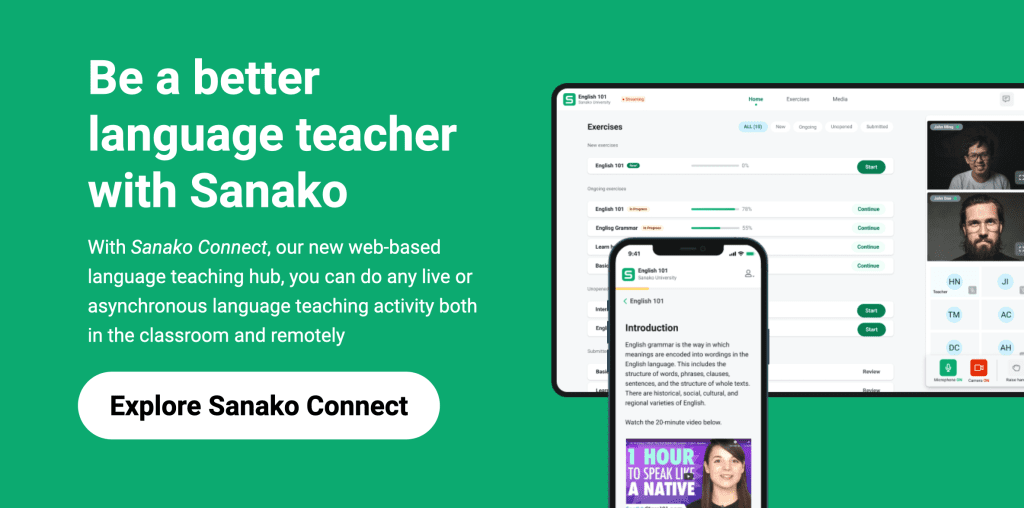With products being regularly used by more than 6 million learners every week and with a presence in over 50,000 classrooms across 114 countries, Sanako is at the forefront of the language learning industry. Since its launch in 1961, its business has shifted from physical language laboratories to cloud-based digital solutions. As such, we at Sanako can offer a unique perspective on the changing technological and pedagogical forces facing the industry at the end of 2023.
In this blog post, we identify the four main challenges that our customers report that they are currently addressing in their language classrooms. We also highlight ways in which educational technology solutions are already helping educators to address them.
The changing language teaching landscape
Language teaching and learning is the middle of a technological revolution. But it’s been that way since the first language labs appeared in schools in the mid 1900s.
Operating originally as Tandberg Educational, Sanako was one of the pioneers in developing and installing physical language learning labs in schools. For the first time, students were able to practise speaking a foreign language, usually by reading texts chosen by the teacher. These sessions were recorded by a central console, and the teacher / student could then revisit the recordings to identify areas for improvement. Over time, students were able to listen to authentic content in their target language and to repeat the words and phrases which they heard.
A second revolution in language learning occurred when desktop computers began to become a regular presence in classrooms. Students were now able to take more control of their learning, in particular around the recording and playback of audio / spoken content. Whilst teachers were able to create, tailor and share a more engaging breadth of content and resources.
Educators and learners are now in the third wave of technological transformation as language learning moves into the cloud. With the advent of high speed internet access and universal ownership of smart mobile devices, students and teachers are no longer tied to the classroom or institution. They can learn when they like, what they like and where they like. This shift has also made it significantly easier for classes to connect with native speakers as well as exponentially expanding the universe of available learning resources. However, these advances inevitably present a new range of challenges and questions for educators and institutions.
Challenge 1: How can I get my students to talk more in their target language?
The ability to hold a conversation with a native speaker is the main objective for most language learners. Whether they’re looking to order ice cream in Venice, catch a plane in Madrid or hold a business negotiation in Tokyo, their true measure of success is to conduct it in the local language.
Yet many language learners in both formal and informal settings struggle to spend much time practising their speaking skills. In fact, Sanako’s customer research suggests that students actually only spend 1 or 2% of an average lesson speaking. More specifically, additional Sanako research found that each student in a class of 30 students would typically only have 21 seconds of speaking time in an average 45 minute lesson. This is due to many factors: a greater focus on grammar and text-based learning; shyness or fear of being criticised; the vocal minority taking the lead or simply that some teachers / teaching approaches are inefficient and don’t optimise available lesson time.
However there’s clear evidence that digital solutions can address this challenge, increasing students’ speaking time in an average lesson to 10 minutes or more. Sanako’s Connect product, for example, broadens access to speaking opportunities, enabling students to practise in class or at distance, on their own or with a partner. Automated pronunciation grading tools enable language learners to quickly receive feedback on their speech, helping them to identify where improvement is needed. Teachers can also quickly review individual and class audio files, highlighting exactly where something could be improved. All of the above help build confidence and motivation, encouraging students to persist and to improve.
Challenge 2: How can I get my students engaged in their learning?
Every year Sanako asks educators to share their experience of being a language teacher. Every year we ask them “What’s your number 1 challenge?” Every year increasing student motivation tops the list!
In formal education settings, where students are required to learn a second language, this can be a real problem as disengaged students can impact the whole class’ motivation. The same also applies in informal language institutions, where high drop-out rates can impact the school’s financial viability. Motivation matters!
The biggest impact that technology can have on this challenge is to help educators personalise learning for their students. Course content, quizzes, and feedback can all be carefully tailored to individual students using digital portals such as Connect. Educators can also use a broader range of online content (e.g blogs, podcasts, YouTube videos) in their lessons as well as encouraging students to submit work in digital form (e.g presentations, TikToks or videos). The addition of gamified elements that keep students trying to beat their high score also helps engagement and builds students’ motivation for learning.
Challenge 3: Creating lesson plans and resources
However it is important to acknowledge that there is significant extra work for educators in responding to the challenges outlined above. Tailored resources need to be created and shared for each lesson and / or each student, which takes significant amounts of time and sometimes expense. Unfortunately, much of that work ends up being done in teachers’ free time, which has obvious implications for their work-life balance.
Clearly the internet offers educators access to a wealth of high-quality digital language content, but digital tools can also help reduce the effort / time they spend on lesson preparation. Connect, for example, enables educators to create lessons in the portal – they can easily upload a wide variety of learning material for students to work through and can use pre-prepared templates for common language teaching activities. All of which can then be shared with students via a unique URL. It’s worth noting that educators are also able to save and organise all of their lesson content on Sanako Connect. These resources can then be easily reused and repurposed for other age groups or for future classes.
Challenge 4: Giving specific, individualised feedback
Learning a new language can be a long and frustrating process for students. They’re often not sure if they are making any progress, which obviously impacts their focus and motivation. Feedback highlighting where they’re going wrong and where / how improvements could be made is therefore vital to maintain progress.
Educators, of course, recognise this but face significant challenges in delivering that feedback to their students. In the first instance, those students might be learning remotely. But even in classroom settings, it can be challenging to mark and give feedback to 30+ students about a piece of work they have submitted.
Again digital tools are here to help! Once the lesson has been completed by all students, educators are then able to use Connect’s unique functionality to easily review the materials submitted. They can switch views to look at the work submitted by individual students or use a whole class view of their collective performance in specific assignments. The latter enables educators to clearly identify where the class is struggling and where additional work is needed to clarify or consolidate learning. Importantly, these precise feedback mechanisms enable educators to carefully target / personalise subsequent lessons and enhance ongoing academic attainment.
Inevitably the pace of technological change will continue to quicken. The development of online technologies such as the Metaverse may, for example, offer significant potential for immersive online language learning. However, such tools should continue to be seen as a supplement to, rather than a replacement for, best classroom practice. Their advantage lies in freeing teachers to do the things that technology cannot – helping students to achieve and delivering pastoral support, for example.
If you’d like to find out more about how Sanako Connect could help to transform your language teaching, click here or the banner below to arrange your FREE demo!

